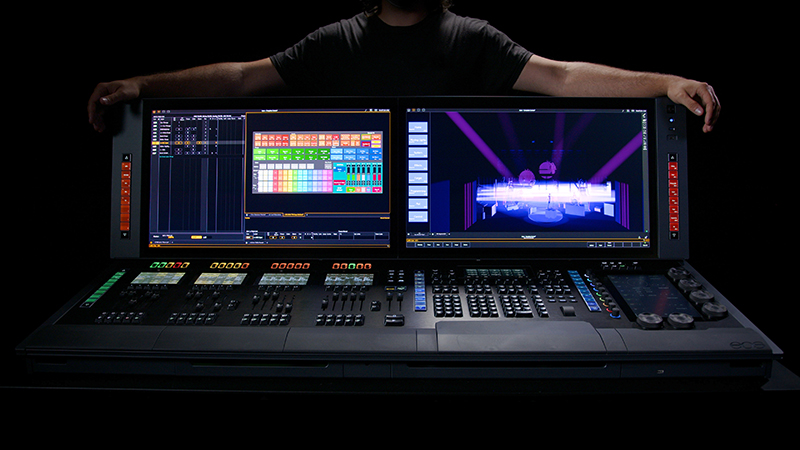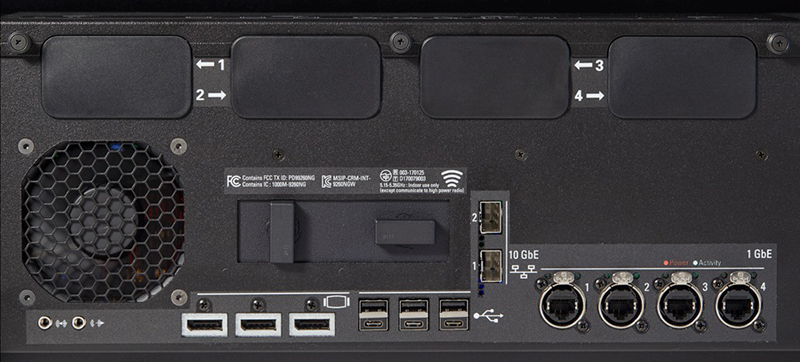
I have worked with—and been around—consoles for most of my working life, first as a lightboard operator then console programmer, and later in sales and marketing of consoles at the manufacturer level. I know very well what goes on with the development of consoles and that here is a whole team of people behind their thoughtful design and implementation. For full disclosure, I worked as a Regional Sales Manager at Electronic Theatre Controls (ETC) in the early 90s when the company launched the Source Four ellipsoidal, the Sensor dimmer, and the Obsession line of consoles. I have nothing but respect for the many people at ETC who designed and developed their consoles over the years from Fred Foster and Jon Ide through Anne Valentino and Dennis Varian to today’s Eos line of consoles led by Eos Product Manager, Nick Gonsman and Eos Technical Product Manager, Matt Halberstadt. So I was not surprised, but yet again impressed in March when ETC raised the bar for lighting control with the launch of the Eos Apex, the next generation of ETC’s flagship line of lighting control consoles.
Gonsman, Halberstadt, and the product management team, as well as to the developers and engineers behind the Eos Apex console line should be rightfully proud of the well-deserved positive response to the new consoles. It’s quite apparent that they have really listened to programmers and end users in the development of the Apex line. ETC notes that the Apex consoles offer a sleek control interface engineered for the programmer/operator’s comfort and customization. With generous programming surfaces and the power to run complex rigs, it is designed as the ultimate hands-on, professional workspace—powered by ETC’s Eos control platform.

Enhanced User Experience
Eos Apex consoles prioritize the user experience with creature comforts to ease those long hours behind the desk for programmers. The massive multitouch displays offer generous screen real estate for Magic Sheets, Direct Selects, and Augment3d models, and feature eye-strain-reducing 4K resolution. The displays articulate on a dual-axis and feature a 160˚ viewing angle, so you can see all your tools and data from anywhere along the programming surface. And the displays are massive—Apex 5 features one 23.8” 4K multitouch display; the Apex 10 has two 23.8” 4K multitouch displays; and the Apex 20 has two 27” 4K multitouch displays. With an ergonomically redesigned wrist-rest, book lights for paperwork built into the sides of the desk, handholds for easy carrying, and drawers and charging ports for your accessories, Eos Apex is rightfully stated by ETC as being the ultimate workspace for programmers.
There are several state-of-the-art features including customizable OLED Target Keys for Direct Selects, a built-in 5” haptic multitouch soft keypad, and more encoders than ever before on an Eos desk. The Apex line offers three sizes of console to choose from—the smallest is the Eos Apex 5 which measures 17.58” H x 34.00” W x 25.53” D and weighs only 97 lbs.; the midsized Eos Apex 10 measures 17.58” H x 48.00” W x 25.53” D and weighs 135 lbs., and the largest being the Eos Apex 20 measures 19.64” H x 56.00” W x 25.53” D and weighs in at 147 lbs. With reconfigurable inputs and outputs, you can tailor your Apex experience to the needs of your venue or production. While it should be noted that these new consoles directly replace the Eos Ti and Gio in ETC’s currently-shipping lineup, those legacy desks will continue to receive new software updates, as well as the full benefit of ETC’s industry-leading customer service and support for the duration of their lives in the field.
As for the programming surface, there are new-to-the-industry technologies that provide programmers access to their most-used tools—right on the face panel. The familiar Eos Family programming keypad has been enhanced with a touchscreen that thumps with haptic feedback when you press your soft keys or mapped content. The customizable Target Keys for Direct Selects have individual OLED displays that can be customized with images, icons, and text. The encoder area from the Eos Ti console has been expanded to include eight mini-encoders and a navigation dial to easily switch between parameters. The five, 10, and 20 motorized Playbacks on each Apex console (respectively) now have an additional, separately mappable scroll wheel for on-the-fly programming. With more buttons, encoders, and Playbacks than ever before, Eos Apex makes fast, hands-on programming a breeze—all while maintaining the familiar, sophisticated look and feel that users of the Eos family already appreciate.

Customize Your System
Apex consoles themselves are built with flexible system-building in mind, allowing you to mix and match your DMX and show control ports on a per-show basis using customizable widgets. Apex consoles include six Ethernet ports (four standard etherCON Gigabit ports, and two 10-Gigabit SFP+ ports) that can connect to copper or fiber optic runs—right at the back of the desk. With these connections, users can take advantage of the latest high-speed infrastructure to run the lighting network, allowing blazing-fast primary and backup communication to all show-critical system components.
Eos Apex consoles and processors provide 24K output, allowing them to control complex rigs with ease. And because shows keep getting bigger and bigger, expansion processing options are already in the works as the next phase of Eos development.
If you prefer to connect devices directly to your console, the customizable I/O Garage on each Apex console lets you mix and match your outputs on a per-show basis. Simply dock the appropriate gateways in the garage to get a little more DMX output on one show and a little more MIDI on the next. There are a range of Backpack Gateways including the Response Show Control Gateways that cover MIDI, SMPTE, and Serial control, as well as the Gadget II DMX Gateway that’s a portable 2-port DMX output for Eos Apex consoles (as well as for PC- and Mac-based ETCnomad control).
Processing Power
A powerful lighting desk demands a powerful system, and the Eos Apex line delivers with brand-new components to build out your lighting network. The Eos Apex Processor provides the power of an Eos Apex console in a portable, rack-mountable box that makes an ideal primary or backup controller or remote programming station. When you need a portal into your lighting system but not the processing power, the new Eos Remote Interface lets you view and edit your system from anywhere in your venue.
ETC feels that the Eos Apex line ushers in a new era of control and comfort for professional programmers. Certainly a wide range of markets will see the benefit of using the Eos Apex. If you program for a living, I strongly suggest you contact ETC, or your ETC dealer, to arrange a hands-on demonstration of the Eos Apex consoles. Try the Eos Apex consoles out for yourself and see what they can do for you and the way you work. To get you started, ETC has created a dedicated interactive landing page for the Eos Apex line of consoles. There are videos, data sheets, and more information about the consoles and accessories as well as the other consoles in the Eos controls family at www.etcconnect.com/Apex/


